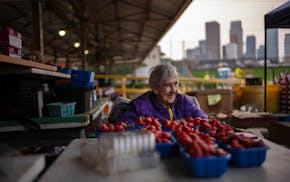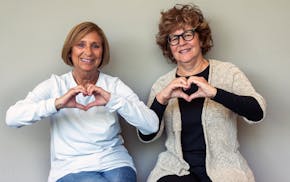WARROAD, MINN. – Construction was still whirring when John Davis swung open the new art center's back door and started the tour. He led a dozen people through the 320-seat performance space, pointing out the acoustic panels, the sprung floor, the LED lighting.
Then he showed where the docks would go in.
"To keep out the skeeters," Davis said, pulling a screen across a wide patio doorway to the river, "we've got a screen here that tucks in."
The group gave a collective "oooh," murmuring and nodding. One was a visual artist, another a theater director. But Davis knew that all of them were Warroad residents who knew the value of a screen, a dock, a spot on the river.
Davis has spent his career nurturing the arts in rural places. In the '80s and '90s, he turned New York Mills, then population 950, into a national model for using the arts to revive a rural economy. Then he helped make picturesque Lanesboro, population 750, into an arts destination. Now, the 63-year-old is trying to do the same in Warroad, population 1,800.
His mantra has been the same: "In a small town, your audience is everyone."
But what each small town needs is different. This city near the Canadian border is best known for hockey, walleye and windows. Arts, not so much.
So Davis has been working to make Warroad RiverPlace, a new $20 million arts, culture and events center, opening this weekend, relevant to hockey fans, fishermen and people who work at Marvin Windows, the biggest employer in town. (A lead donation from Frank Marvin, the company's former president, and his wife, Margaret, helped cover RiverPlace's construction.)
For months, the nonprofit center's staff, including Davis, its executive director, have been meeting not only with the Warroad Summer Theatre, which will stage plays in the high-tech performance space, but with local snowmobile clubs.
"RiverPlace is going to be the first art center in the nation that's going to be accessible by snowmobile, cross country ski, boat, kayak, canoe and seaplane," Davis said.
That's important to Jared Olafson, a lifelong Warroad resident along for this tour. With his neighbors and his kids, the 44-year-old plows a 5-mile skate path along the Warroad River each winter, a pandemic project that's become a tourist draw. That path, lined with cross-country ski and snowmobile trails on either side, will soon bring ice skaters to RiverPlace, a modern structure perched along the river.
And in the summer, Olafson hopes to take a leisurely 15-minute boat ride from his place to RiverPlace. So ever since he heard about the project, he's been pushing Davis to install docks.
"My thought was, how is an arts center going to fly in northern Minnesota?" said Olafson, director for the Warroad port of entry, the border crossing 6 miles north of the city. "It's a lot of rednecks, right? But then, as it comes to fruition, the grand plan of it, it's much more than just art.
"It kind of encompasses everything."
For example, most folks' wedding receptions take place at the ice arena, the largest space in town. Now, they can host them at RiverPlace, which boasts a catering kitchen, he said. "I told my wife, how nice would this have been?"
Working with Davis on the docks, Olafson has been struck by his tenacity.
"Even if it were just an arts center, I think he would be that bulldog and not let go and still make it thrive."
'The difference-maker'
In a photo from 1991, Davis stands on his dirt driveway near New York Mills wearing a thick coat and a half smile.
A painter and a sculptor who grew up in Minneapolis and Indiana, Davis graduated from the Minneapolis College of Art and Design and moved to the west-central Minnesota city. He paid $10,000 for the long-abandoned farm, restoring it and turning it into an artists' retreat. To make money, he painted barns.
Only after being a part of the community for years did he raise $120,000 to remodel the oldest brick building in town, transforming it into a cultural center.
"I think that's the difference-maker," said Betsy Roder, executive director of the New York Mills Regional Cultural Center, founded in 1990. "He didn't come swooping in saying, 'Hey, I'm this big-city artist guy who knows everything, so you should give me money.'
"He was part of the community and rooting for the community to grow in this way."
It was there, long before "creative placemaking" became a buzzword, that Davis learned to talk to bankers and skeptical City Council members in economic terms. Part of his pitch was that it would cost the city more to demolish the building than to invest in a new cultural center. The city contributed $35,000, according to a 1991 Star Tribune article, then the per capita equivalent of $13.7 million in Minneapolis.
"At a certain point, people become comfortable with you," he said. "You can speak their language."
What happened next has become legend among rural arts organizations: Within five years, 17 new businesses opened or moved to town, creating 210 new jobs, according to a National Endowment for the Arts write-up in 2011. More than that, it changed the culture of New York Mills. The city drew tourists for the Great American Think-Off. Kids worked on projects alongside artists from Minneapolis and New York City, France and England.
Roder was one of those kids. When she left for Valparaiso University, she wore with pride the cultural center's T-shirt, with its tractor logo. A decade ago, after working at Target and earning her MBA, she and her husband returned to New York Mills to raise their kids. The arts are key to attracting and keeping such "rural rebounders," she said.
She's eager to see what Davis can accomplish in Warroad, given his background and, "to be fully frank," the project's major private support. "I joke with him: 'You want to slide a couple million over to me?"
"It will be good for the whole arts community," Roder said, "to show that hey, if you invest this money and you believe, look what can happen!"
'What do you imagine?'
After 18 years with Lanesboro Arts and two years on a prestigious Bush Foundation fellowship, Davis was "perfectly happy in semi-poverty retirement."
Then Warroad called.
A recruiter had asked Sue Gens, executive director of the Minnesota State Arts Board, if she knew someone who could start an arts center from scratch on the Canadian border.
"I said, 'Call John Davis,'" said Gens, who has known Davis since his time in New York Mills. She didn't think he'd take the job but knew he'd be a great match. "He really becomes part of the community. And he says, 'What are your hopes and dreams? What do you imagine? How can this be possible?'"
Davis was inspired by the challenge.
"I've had to use every single skill that I've gained over my relatively long career doing this, working with a new town," he said.
Partly because the center's construction was paid for by private donations, including from the beloved grandparents of the Marvin family, RiverPlace hasn't encountered controversy. Tours have helped, too.
The community theater folks are "jumping for joy," said Jenee Provance, who met her husband, Jim, while doing Warroad Summer Theatre. "That studio over there is every artist's dream," said Shawna Boulette Grapentine, a Oji-Cree visual artist.
"It's all about hockey and robotics here," said Kristen Schneider, who works at the Wm. S. Marvin Training and Visitor Center. "So the art center just gives that glimmer of hope for children that have a different craft."
But there have been other challenges.
A week into the job, Davis discovered MnDOT's plans to replace an intersection on Hwy. 11, across the street from the arts center, with a roundabout, altering its connections to that street and downtown. Davis believes stoplights ensure access for children, the elderly and the visually impaired, and he worries about how those plans will impede his access-for-all mission.
"It's a community killer," he said.
MnDOT has argued that studies show roundabouts are safer for pedestrians, both by slowing traffic and shortening the distance that they are in harm's way, said Darren Laesch, assistant district engineer for MnDOT's northwest district.
"As far as access goes, in my opinion, a roundabout provides better access for people to utilize that intersection," Laesch said.
Plans for the building, too, were keeping Davis up at night. Talking with restaurant owners in town, it became clear that they needed to add a walk-in cooler. (They did so.) And there just wasn't enough storage. Architects assumed, based on big-city projects, that they'd rent tables and chairs for events, "which just wasn't a reality-based scenario," he said.
So Davis, who has worked as a general contractor, sketched out a solution.
He gets wide-eyed when talking about these hiccups, shaking his head. But when discussing how the arts can help solve knottier issues, he exudes only optimism.
He believes this arts center will aid Marvin's efforts to retain employees, including dozens of families recruited from Florida and Puerto Rico through a new program called the Path North. He's talking with Minneapolis-based Mixed Blood Theatre about involving workers in the creation and staging of a bilingual play.
He expects that art will help the city address other challenges, too, including creating more affordable housing.
And he's confident that once the center opens and community members see all that's possible, he'll be able to fundraise for its $600,000 to $650,000 a year operating budget. True to form, he hasn't made requests yet.
He wants people to experience the 20,000-square-foot facility, which is hosting a "grand welcoming" this weekend. To see "welcome" on the massive video wall in Spanish, Laotian and Ojibwe. To peruse the gallery, to hear a concert. To consider how a place like this might attract a family driving from Winnipeg or kayaking from just around the bend.

18 dance and theater events to catch outdoors in Minnesota this summer

Embrace Minnesota's growing seasons at these 76 farmers markets

Old School Jewish Matchmakers offer timeless perspective on dating


